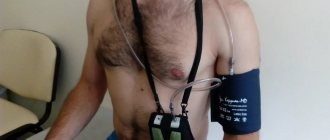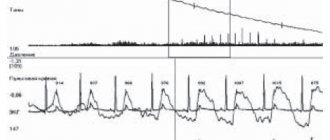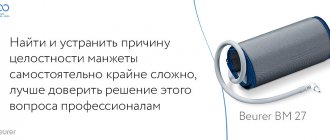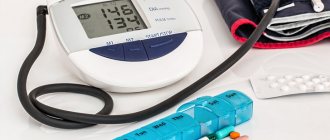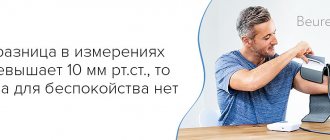HOLTER HELL, HOLTER ECG - Daily (Holter) monitoring of ECG and blood pressure. This is a method for diagnosing diseases of the cardiovascular system, which is based not on short-term ECG diagnostics, but on collecting information over a long period of time (hours, days, days). If the cardiologist cannot identify the causes of the malfunction of the heart muscle, then the patient is prescribed daily ECG monitoring, which can last up to 7 days. Compared with standard ECG and ECG under physical activity, 24-hour ECG monitoring can more clearly identify myocardial ischemia and paroxysmal cardiac arrhythmias. Daily (Holter) ECG monitoring allows you to identify heart activity in the patient’s usual living conditions, and subsequently develop a more appropriate treatment plan depending on the patient’s habits.
Currently, two types of monitoring are carried out:
- Holter ECG monitoring
: diagnosis is similar to the standard ECG procedure, the only difference is in the time intervals (the procedure can last up to 7 days) and that the data is recorded in the memory of a wearable device, and not on a piece of paper. - Daily Holter monitoring (ECG + blood pressure)
: in addition to recording an ECG (as described above), the patient is wearing special cuffs with a portable tonometer, which also records the patient’s blood pressure data into the device’s memory. This method is more common, because it allows you to detect a disruption in the rhythm of the heart and record a temporary disturbance in the functioning of the myocardium.
What is the technique
ABPM - 24-hour blood pressure monitoring - also called holter blood pressure. The study allows the doctor to give a full assessment of the patient’s blood pressure, since the indicators are continuously taken and recorded over a 24-hour period. ABPM is used to confirm or remove the diagnosis of hypertension.
In some cases, blood pressure holter is performed for hypotension.
ABPM is also prescribed to patients with a confirmed diagnosis of hypertension in order to monitor the effectiveness of selected drug therapy. If necessary, treatment will be adjusted based on the results obtained.
The test involves wearing a blood pressure cuff and a device that records the readings. The device independently initiates the latter at certain time intervals. Most often, every 30 – 60 minutes. Blood pressure measurements are carried out regardless of a person’s activity - he can either simply relax or engage in current affairs. Based on the received readings, a schedule is built, which the specialist uses to evaluate and issue a conclusion.
Decoding the device readings
After the device is removed, the cardiologist will enter information from it and the blood pressure monitoring diary into a computer program.
It processes the information received and analyzes data on this patient. Then the patient’s daily electrocardiogram is displayed on the screen. By deciphering its indicators, the doctor can obtain an objective picture of the course of the disease and prescribe/adjust treatment. If the study is carried out by experienced cardiologists, it takes very little time to decipher the obtained indicators and compare them with data from the patient’s diary - about 20 minutes. The result is issued in paper or electronic form.
From everything written above, the following conclusions follow:
- Holter examination is the best way to diagnose many diseases of the cardiovascular system;
- this method is simple, convenient, and has no contraindications;
- the cost of a study in a clinic is affordable for any budget, usually it ranges from 2–4 thousand rubles;
- Based on the examination results, the doctor can prescribe effective treatment and alleviate the course of the disease.
Indications for blood pressure holter
The method of daily blood pressure monitoring is prescribed in the following cases:
- significant changes in blood pressure levels both during measurements in the doctor’s office and independently;
- high blood pressure values not accompanied by signs of target organ damage - heart, fundus, kidneys, brain;
- blood pressure values are within acceptable limits in the presence of target organ damage (left ventricular hypertrophy, fundus lesions), as well as identification of risk factors for arterial hypertension;
- lack of results from selected antihypertensive drugs;
- episodic hypotension detected in elderly patients, including patients with diabetes mellitus;
- elevated blood pressure during pregnancy, with suspected pre-ellipsia.
ABPM makes it possible to diagnose so-called “white coat” hypertension, as well as masked and persistent hypertension.
White coat hypertension . Quite a common occurrence. Blood pressure levels increase to critical levels only when measured in the doctor’s cabin. Treatment in this case is not carried out, since surges in blood pressure are a physiological reaction of the body.
Masked. In this case, the blood pressure norm is noted exclusively in the doctor’s office. ABPM makes it possible to detect its persistent increase throughout the day.
Sustainable. With this type of hypertension, blood pressure indicators remain consistently elevated, regardless of the location of measurement.
Holter blood pressure is used to predict possible cerebrovascular and coronary complications that develop against the background of hypertension.
Absolute contraindications to ABPM are:
- complications that developed in the previous study;
- damage to the skin in the area where the cuff is applied;
- any bleeding disorders, in particular thrombocytopathy, thrombocytopenia;
- period of exacerbation of blood pathologies;
- vascular damage of the upper extremities;
- hand injury.
Among the disadvantages of the technique, it is worth highlighting the discomfort during night sleep, since measurements are taken around the clock.
What is the essence of the study
Daily monitoring is a reliable way to see how well a person’s heart and blood vessels cope with their functions. It is impossible to obtain such information by measuring blood pressure from time to time, since blood pressure surges and heart rhythm disturbances may occur irregularly. In addition, a number of diseases are characterized by mixed symptoms - a whole range of deviations from the norm appears. Therefore, doctors suggest that people who suffer from high blood pressure and are in the so-called “risk group” start filling out a diary of blood pressure fluctuations.
Features of Holter blood pressure monitoring
The technique assumes that the patient will strictly follow the rules and recommendations of the specialist. Otherwise, the readings will be incorrect, which will negatively affect the diagnosis and selection of drug treatment.
ABPM is a simple procedure. A “cuff” is placed on the patient’s arm with a device in the form of a small box attached to it using wires, to which the results of each measurement will be automatically transferred and recorded in memory.
During the entire period of wearing the cuff, a person is required to keep an observation diary in which he must record all the actions he performs during the monitoring period. It is necessary to write down with the exact time:
- time of falling asleep - waking up;
- any physical activity;
- taking medications;
- development of a stressful situation;
- meal.
The diary must indicate any changes in well-being, for example, the appearance of painful sensations.
The total duration of the study is 24 – 28 hours. The first two hours after installation of the cuff are excluded when constructing the graph as adaptation. Our specialist comes to the patient at the appointed time to remove the device. The specialist then extracts the received data to perform processing. The result is given to the patient. The interpretation is carried out by the attending cardiologist.
Why keep a diary of blood pressure changes?
Keeping a blood pressure self-monitoring diary is the right decision for patients suffering from arterial hypertension and heart problems.
It is necessary because it helps to notice not only the time of day at which a person usually experiences surges in blood pressure, but also to track the patient’s body’s reaction to taking certain medications. Most often, the diary is filled out on a form in which the following information is entered:
- date of;
- Times of Day;
- well-being;
- medications taken;
- heart rate and pressure indicators.
Recommendations from experts
In order for a specialist to receive the most complete and accurate information, a person must behave as naturally as possible and do his usual activities.
But, nevertheless, there are a number of recommendations that the patient must strictly follow:
- the study is carried out against the background of the usual lifestyle - in order not to distort the results, it is not recommended to make any changes to the usual routine;
- the accuracy of the measurement depends on the location of the cuff - if it has moved, return it to its original position (this must be indicated in the diary);
- before starting the measurement, the device beeps - at this moment the hand must be relaxed and kept motionless until the measurement is completed (the cuff is loosened);
- it is forbidden to pinch the tube connecting the cuff and the recorder;
- It is prohibited to take a shower or bath with the cuff on;
- The device must not be wetted, cooled, or exposed to electromagnetic radiation.
Holter AD is an effective technique that allows you to establish an accurate diagnosis and select treatment that is adequate to a person’s current condition. ABPM may show an incorrect result when taking medications, the frequency and dosage of which was unknown to the specialist interpreting the results.
The Extendiagnostics clinic offers 24-hour blood pressure monitoring. If necessary, the procedure for installing the device and its subsequent removal can be performed at the patient’s home. We are always ready to meet you halfway. You can sign up for the study by calling and choosing a time convenient for you.
Who needs research
Indications for this examination include a number of pathological conditions of the patient:
- pain, heaviness behind the sternum;
- the presence of diabetes mellitus in the patient;
- pain in the heart, which can appear spontaneously or be observed constantly, occur even in a calm state or after emotional/physical stress;
- increased incidence of fainting, sudden dizziness, shortness of breath after exercise or at rest;
- diseases of the thyroid gland of various etiologies;
- recent heart attack.
Also, a study using the Holter method is carried out to clarify the effectiveness of the therapy prescribed by the doctor.
Is preparation required?
To pass the examination, serious preparation is not needed. If the doctor considers it necessary, the patient may first undergo a regular electrocardiogram. In addition, men with significant chest hair removal are recommended. This is necessary because the Holter electrodes will be placed near the heart by the doctor, and failure to follow this recommendation may affect the quality of the study. There are no contraindications for examination using the Holter method.
How to prepare for the test
It is recommended to wear comfortable clothing, such as a short-sleeved T-shirt and loose, wide-sleeved outerwear. Before the test (at least 24 hours), you should stop drinking alcohol. There is no ban on pharmaceuticals: before the examination, the patient can take all medications prescribed by the doctor.
The patient may be asked to keep a special diary in which to record important information that may affect blood pressure values. For example:
- the time when a person falls asleep, wakes up, gets out of bed;
- meal times;
- time and name of medications taken;
- any feeling of discomfort;
- other events that can affect blood pressure (stress, exercise, etc.).
Registration of ABPM does not interfere with the patient’s normal life; at this time he can work and perform all daily activities. But there will still be minimal discomfort: it is not recommended to lie on the arm that is wearing the cuff, and you cannot remove it from one arm and put it on the other. It is also important to protect the ABPM device from moisture and direct sunlight.
Which brand of monitors is preferable to install?
The favorite is considered to be St. Petersburg, which produces some of the best cardiac recorder devices. In addition to the quality of the equipment, the installed software for data recording and processing is unique in the number of functions.
All our monitors were released by this company in 2013 and 2021. and meet the requirements of functional diagnostic specialists. You can see them in the attached photos.
The advantage of a receptionist in our clinic
Typically, the recorder, connected to the patient via an attached cable, is carried in a specific bag (case) via a shoulder strap. In addition to the easy detection of such a patient with a monitor by a prying eye, it is still embarrassing at night, in the summer and introduces certain household restrictions. We have a unique, convenient monitor “Cardiotechnika-07-3” from INKART, produced in 2021, all the wires of which and the small recorder itself are placed on the patient’s body, without the need to wear any bag. This monitor is easily hidden under clothing and is inaccessible to prying eyes, which makes it possible for patients to visit work, school, and other public places without any embarrassment. Not to mention the convenience in the summer and at night. As a rule, anyone who has worn it at least once asks to install just such a monitor again in the future. We provide you with this opportunity, but we ask you to use the keyword “wireless” when making an application to the clinic. Such a monitor records 8 channels, optimally selected for a high-quality search for both ischemia and arrhythmia, and does not differ in the quality of the information provided from a 12-channel recording. The convenience of this recorder has made it extremely popular in our clinic and the best for recording HM-ECG in children and adolescents.
All wearable recorders in our clinic have the necessary certificates and undergo annual verification.
How is ABPM performed?
As a rule, a device for measuring daily pressure is installed in the morning or afternoon. Before installing the device, a person’s blood pressure is first measured using a conventional tonometer, and only after that the daily device is fixed.
A cuff is placed on the lower half of the shoulder and secured, as with a normal pressure measurement with a tonometer. Several test readings are taken. After this, the indicators are checked: if the values concur with a conventional tonometer, the patient is sent home exactly for 24 hours.
What patients say
According to reviews of people who completed this study, they did not experience any pain or discomfort while wearing the device.
The device leaves some inconveniences during sleep and active loads, but they are not significant. Important! It is worth getting a certificate from your doctor stating that you are undergoing a study using the Holter method - it is presented to law enforcement officers, it explains the purpose of the device and the essence of its work.
A complete comprehensive diagnosis of the functioning of blood vessels and the heart is the key to your health for many years.
